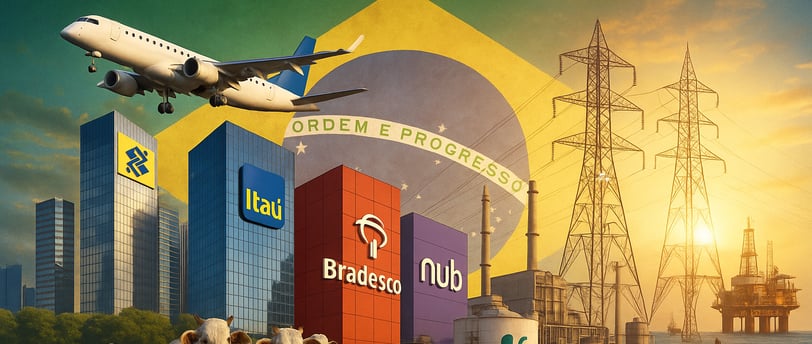Investing in Brazil: Opportunities and Challenges in a Dynamic Economy
Explore the multifaceted landscape of Brazil's economy, from its robust agricultural sector to the challenges in its industrial domain. Understand the investment vehicles available, including stocks and bonds, and assess the associated risks and opportunities. Delve into the country's macroeconomic indicators, the stability of its banking and utility sectors, and the potential impacts of the upcoming 2026 elections on the investment climate.
EMERGING MARKETSBRAZILSOUTH AMERICA
5/31/20254 min read


Introduction
Brazil, the largest economy in South America, offers a diverse investment landscape characterized by a strong agricultural sector, a mix of thriving and stagnating industries, and a complex political environment. This article provides an in-depth analysis of Brazil's economic sectors, investment vehicles, and the associated opportunities and risks for investors.
Agricultural and Livestock Sector: A Global Leader
Brazil's agricultural prowess is undeniable, positioning the country as a global leader in both crop and livestock production. In 2024, Brazil was the world's largest exporter of several key commodities, including coffee, soybeans, beef, and poultry. The country's agricultural sector contributes significantly to its GDP and employment, with agribusiness accounting for approximately 25% of the national GDP and employing 27% of the population. (ft.com)
The "Plano Safra" is a pivotal government initiative designed to support the agricultural sector by providing subsidized credit lines to farmers. This program aims to enhance productivity, promote sustainable practices, and ensure food security. By facilitating access to financing, the Plano Safra has been instrumental in driving the rapid growth and high productivity observed in Brazil's agriculture.
However, the sector faces challenges, including environmental concerns such as deforestation and climate change. Innovative practices like the integration of agriculture, livestock, and forestry (ILPF) are being adopted to promote sustainability. For instance, the Wolf family in Nova Canaã do Norte has successfully implemented ILPF, resulting in increased productivity and environmental benefits. (elpais.com)
Industrial Sector: Stagnation Amidst Pockets of Excellence
While agriculture thrives, Brazil's industrial sector has experienced stagnation over the years. Several factors contribute to this, including high production costs, bureaucratic hurdles, and infrastructure deficiencies. Despite these challenges, certain companies have emerged as exceptions, demonstrating resilience and global competitiveness:
WEG: A multinational corporation specializing in electrical equipment, WEG has expanded its footprint globally, offering products ranging from electric motors to automation systems.
Embraer: As one of the world's leading aircraft manufacturers, Embraer has a strong presence in commercial, military, and executive aviation markets.
Vale: A major player in the mining industry, Vale is one of the largest producers of iron ore and nickel worldwide.
Petrobras: The state-controlled oil giant is a significant contributor to Brazil's energy sector, involved in exploration, production, refining, and distribution of oil and gas.
These companies not only bolster Brazil's industrial output but also offer investment opportunities through their publicly traded stocks.
Banking Sector: High Margins and Stability
Brazil's banking sector is characterized by high profit margins and relative stability, making it attractive to investors. The largest banks in the country include:
Banco do Brasil (BBAS3): A state-owned institution offering a wide range of financial services.
Itaú Unibanco (ITUB4): One of the largest private sector banks in Brazil, known for its extensive retail banking network.
Bradesco (BBDC4): A major private bank offering diverse financial products and services.
Nubank: A fintech company that has disrupted the traditional banking model with its digital-first approach.
These banks have demonstrated resilience amidst economic fluctuations, maintaining strong balance sheets and profitability. Investing in their stocks can provide exposure to Brazil's financial sector, which benefits from high interest rates and a large consumer base.
Utility and Energy Companies: Stability and Dividends
Utility and energy companies in Brazil are known for their stability and attractive dividend yields. Key players include:
CEMIG (CEMIG4): A major electricity utility company operating in generation, transmission, and distribution.
Taesa (TAEE11): Specializes in electricity transmission with a robust infrastructure network.
Sanepar (SAPR4) and Sabesp (SBSP3): Leading water and sewage service providers in their respective regions.
Engie Brasil (EGIE3): A subsidiary of the global energy group Engie, focusing on electricity generation and commercialization.
These companies often provide consistent returns to investors through dividends, supported by regulated revenues and essential service provision.
Investment Vehicles: Stocks and Bonds
Investing in Brazilian stocks and bonds offers both opportunities and risks.
Stocks: The IBOVESPA index is the benchmark for the Brazilian stock market. However, it is heavily concentrated in a few companies, which may not provide adequate diversification. Alternative indices like the IDIV focus on dividend-paying stocks, offering potentially more balanced exposure.
Bonds: Brazilian government bonds are known for offering some of the highest real interest rates globally. This can be attractive to investors seeking yield, but it's essential to consider factors such as inflation, currency risk, and political stability.
Macroeconomic Analysis
Brazil's economy is heavily reliant on commodity exports, with agriculture and mining being significant contributors. The services sector also plays a crucial role, encompassing areas like retail, finance, and telecommunications.
In the first quarter of 2025, Brazil's economy demonstrated strong growth, with a 1.4% expansion from the previous quarter and a 2.9% increase year-over-year. This performance was driven by robust agricultural output, particularly a significant 12.2% rise in agriculture due to a bumper soybean harvest. (reuters.com)
However, the economy faces challenges, including fiscal uncertainties, high public debt, and vulnerability to global commodity price fluctuations. Additionally, the Brazilian real has experienced depreciation against the US dollar, impacting inflation and foreign investment.
Political Landscape and the 2026 Elections
Brazil's political environment is marked by volatility, which can influence economic policies and investor confidence. The upcoming 2026 elections add a layer of uncertainty, as potential shifts in government could lead to changes in fiscal policies, regulatory frameworks, and international relations. Investors should monitor political developments closely, as they can have direct implications on market stability and economic growth.
Conclusion
Investing in Brazil presents a complex but potentially rewarding opportunity. The country's strong agricultural sector, stable banking and utility companies, and high-yield bonds offer attractive prospects. However, challenges such as industrial stagnation, political instability, and economic vulnerabilities necessitate careful consideration and due diligence. Diversification, awareness of macroeconomic indicators, and staying informed about political developments are essential strategies for investors looking to navigate Brazil's dynamic market landscape.
Stay updated with finance news and trends.
Contact
info@bullsandbearsblog.com
© 2025. All rights reserved.


